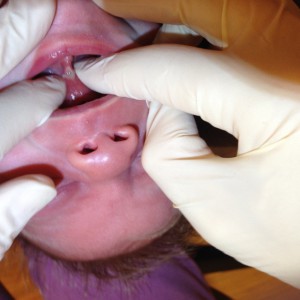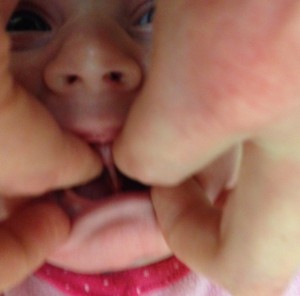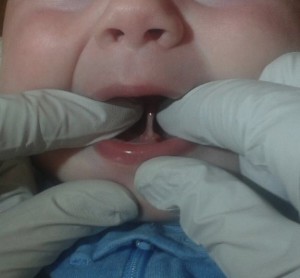Your baby has had a frenotomy/frenectomy (frenectomy is the term for laser frenulum release and frenotomy for scissors) and the last thing you want is for it to heal incorrectly–possibly requiring a second procedure. You probably got a handout with instructions for aftercare. It sounded simple when your IBCLC was discussing it with you. But now that you’re home with baby, it all seems so confusing. What are all these “stretches” and “exercises” people are talking about?
Your provider might call them “stretches,” or “sweeps” or “exercises”. Whatever they are called, there is one purpose–to ensure that the frenotomy site heals as open as possible; which, in turn, will give baby more mobility (movement) of his tongue. We want that beautiful diamond that was created with the frenotomy or frenectomy to stay a beautiful diamond. Just like the one below.

This photo was taken just a few days after a laser frenectomy. The color of the diamond is normal. It will be white or yellowish for a few days before it fades to pink.
Doing effective aftercare means you have to get your fingers in your baby’s mouth. You’re not used to it. It feels strange. And baby likely won’t be thrilled about it either. Keep in mind, however, that there are probably a lot of things that your baby objects to, but you do it anyway, right? You change her diapers, bathe her and put clothes on her–all with some degree of protest from baby.
A few pointers to make this easier for both you and baby. Ask permission–verbally or by gently tapping on mouth with your fingers. Be matter-of-fact about the process and let baby know what you’re doing. Keep it short. Lastly, no need to be rough–you can be gentle and still be effective.
Here’s a short video of a tongue tied baby who is graciously helping to demonstrate aftercare. Most babies–including this one–really dislike anything under the tongue. She lets us know that she is not happy about the “forklift” maneuver, but she is not in any pain. Note: This is before the frenectomy so the frenulum is still present.
The photo below shows the forklift maneuver from the perspective of the parent. Note that the IBCLC in the picture is approaching from the top of the baby’s head. This is the most effective way to get complete separation of tongue and the floor of the mouth. The middle fingers are holding the chin to get separation–not merely a lift of the tongue. If you only lift the tongue, the jaw will follow and separation will not occur.

Gloves are not required if you are the baby’s parent! But some parents do use gloves to do the aftercare because of concerns about fingernails. It’s up to you. Do whatever works for you to ensure that these “exercises” happen at least 6 times per day.
Finally, whether laser or scissors, please schedule a follow up with your IBCLC and your frenotomy/frenectomy provider about 5-7 days post procedure. You and your baby will benefit most from the procedure with timely follow up.
See also: “My Baby is Tongue Tied?”, “Twenty Things You Don’t Know about Tongue Tie”
If you suspect that your baby is tongue tied, I’m happy to help! No matter where you are around the globe, virtual consultations are available. If you’re in the Seattle area, we can meet in your home or at Docere Center for Natural Medicine.
For frenotomies in the Seattle area I highly recommend Dr. Chenelle Roberts at Docere Center for Natural Medicine in the Greenlake neighborhood.



 Some lactation professionals have been trying to address a lack of understanding regarding tongue ties and lip ties for many years. They wanted it better known that tethered oral tissue (term used to refer to all types of “ties”) can negatively impact breastfeeding. But now, with the advent of instant-access social media, we are seeing a trend that is a bit disturbing to these same advocates. We see mothers diagnosing their babies’ tongue ties based on images they see on a Facebook group. We see professionals saying to mothers: “That baby needs a frenotomy,” based on a picture posted to Facebook.
Some lactation professionals have been trying to address a lack of understanding regarding tongue ties and lip ties for many years. They wanted it better known that tethered oral tissue (term used to refer to all types of “ties”) can negatively impact breastfeeding. But now, with the advent of instant-access social media, we are seeing a trend that is a bit disturbing to these same advocates. We see mothers diagnosing their babies’ tongue ties based on images they see on a Facebook group. We see professionals saying to mothers: “That baby needs a frenotomy,” based on a picture posted to Facebook.  Breastfeeding is something that every mother and every baby has a right to do. More importantly, it is widely accepted as the preferred way to feed a baby. We can all rattle off numerous health risks to mom and baby that can result from artificial feeding. It follows, then, that our health care providers—especially those who are charged with the task (and privilege!) of supporting new mothers and vulnerable infants—would be well versed in how to support the breastfeeding dyad. Tragically, this is sometimes not the case.
Breastfeeding is something that every mother and every baby has a right to do. More importantly, it is widely accepted as the preferred way to feed a baby. We can all rattle off numerous health risks to mom and baby that can result from artificial feeding. It follows, then, that our health care providers—especially those who are charged with the task (and privilege!) of supporting new mothers and vulnerable infants—would be well versed in how to support the breastfeeding dyad. Tragically, this is sometimes not the case.